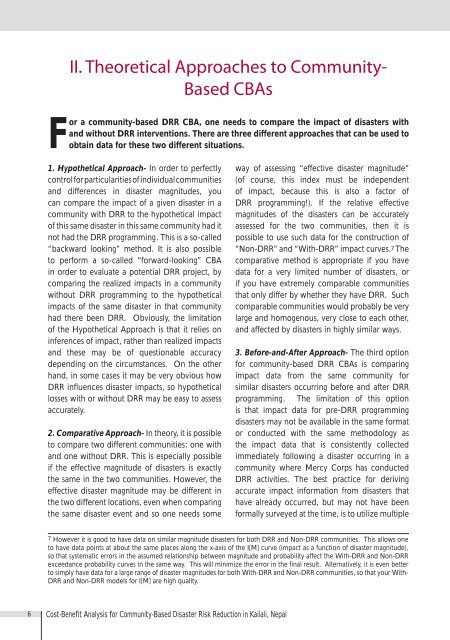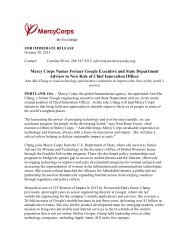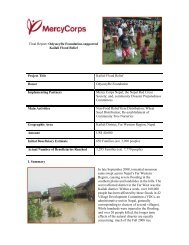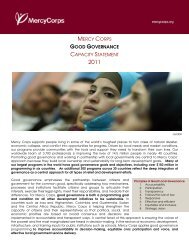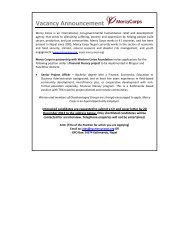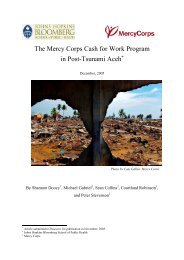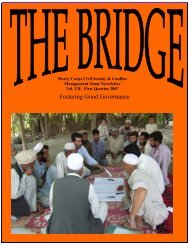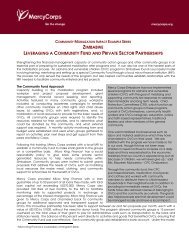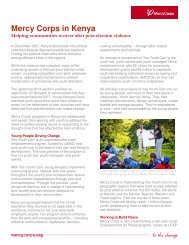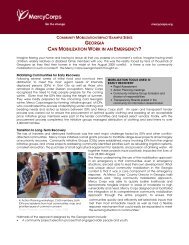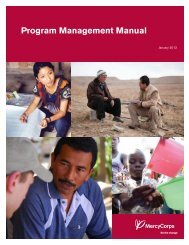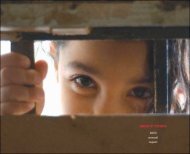A Cost-Benefit Analysis of Community-Based Disaster Risk ...
A Cost-Benefit Analysis of Community-Based Disaster Risk ...
A Cost-Benefit Analysis of Community-Based Disaster Risk ...
You also want an ePaper? Increase the reach of your titles
YUMPU automatically turns print PDFs into web optimized ePapers that Google loves.
II. Theoretical Approaches to <strong>Community</strong>-<strong>Based</strong> CBAsFor a community-based DRR CBA, one needs to compare the impact <strong>of</strong> disasters withand without DRR interventions. There are three different approaches that can be used toobtain data for these two different situations.1. Hypothetical Approach- In order to perfectlycontrol for particularities <strong>of</strong> individual communitiesand differences in disaster magnitudes, youcan compare the impact <strong>of</strong> a given disaster in acommunity with DRR to the hypothetical impact<strong>of</strong> this same disaster in this same community had itnot had the DRR programming. This is a so-called“backward looking” method. It is also possibleto perform a so-called “forward-looking” CBAin order to evaluate a potential DRR project, bycomparing the realized impacts in a communitywithout DRR programming to the hypotheticalimpacts <strong>of</strong> the same disaster in that communityhad there been DRR. Obviously, the limitation<strong>of</strong> the Hypothetical Approach is that it relies oninferences <strong>of</strong> impact, rather than realized impactsand these may be <strong>of</strong> questionable accuracydepending on the circumstances. On the otherhand, in some cases it may be very obvious howDRR influences disaster impacts, so hypotheticallosses with or without DRR may be easy to assessaccurately.2. Comparative Approach- In theory, it is possibleto compare two different communities: one withand one without DRR. This is especially possibleif the effective magnitude <strong>of</strong> disasters is exactlythe same in the two communities. However, theeffective disaster magnitude may be different inthe two different locations, even when comparingthe same disaster event and so one needs someway <strong>of</strong> assessing “effective disaster magnitude”(<strong>of</strong> course, this index must be independent<strong>of</strong> impact, because this is also a factor <strong>of</strong>DRR programming!). If the relative effectivemagnitudes <strong>of</strong> the disasters can be accuratelyassessed for the two communities, then it ispossible to use such data for the construction <strong>of</strong>“Non-DRR” and “With-DRR” impact curves. 7 Thecomparative method is appropriate if you havedata for a very limited number <strong>of</strong> disasters, orif you have extremely comparable communitiesthat only differ by whether they have DRR. Suchcomparable communities would probably be verylarge and homogenous, very close to each other,and affected by disasters in highly similar ways.3. Before-and-After Approach- The third optionfor community-based DRR CBAs is comparingimpact data from the same community forsimilar disasters occurring before and after DRRprogramming. The limitation <strong>of</strong> this optionis that impact data for pre-DRR programmingdisasters may not be available in the same formator conducted with the same methodology asthe impact data that is consistently collectedimmediately following a disaster occurring in acommunity where Mercy Corps has conductedDRR activities. The best practice for derivingaccurate impact information from disasters thathave already occurred, but may not have beenformally surveyed at the time, is to utilize multiple7 However it is good to have data on similar magnitude disasters for both DRR and Non-DRR communities. This allows oneto have data points at about the same places along the x-axis <strong>of</strong> the I[M] curve (impact as a function <strong>of</strong> disaster magnitude),so that systematic errors in the assumed relationship between magnitude and probability affect the With-DRR and Non-DRRexceedance probability curves in the same way. This will minimize the error in the final result. Alternatively, it is even betterto simply have data for a large range <strong>of</strong> disaster magnitudes for both With-DRR and Non-DRR communities, so that your With-DRR and Non-DRR models for I[M] are high quality.6<strong>Cost</strong>-<strong>Benefit</strong> <strong>Analysis</strong> for <strong>Community</strong>-<strong>Based</strong> <strong>Disaster</strong> <strong>Risk</strong> Reduction in Kailali, Nepal


